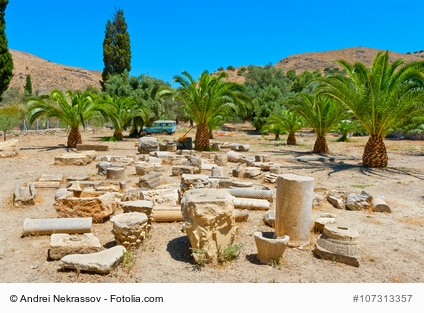|
In ancient times Gortys was for a long time the
largest city on the island of Crete. In its prime, the city had more than a
quarter of a million inhabitants. These are even slightly more than the
largest city of Crete Heraklion today. By then gigantic.
The highest number of inhabitants was in the time of the
Romans. Gortys already existed with the Minoans. But it is one of the few
important excavation sites on the island, which had its climax in the time
of the Dorians and the Romans.

How to get to Gortys: The site is close to the
south coast between Agia Deka and Mires in the Messara plain. Gortys is
located directly on the road between the two towns. The many buses between
Iraklio and Mires stop next to the ancient
city. Some buses go to Mires and then to
Matala
or Agia Galini.
Entrance fee Gortys: 6 Euro, students, children
and persons over 65 years pay 3 Euro.
Opening hours Gortys: To our knowledge every day
from 8 a.m. to 8 p.m. is open. In winter, the excavation closes at 15
o'clock.
The data are from the year 2015.
Caution: On the Peloponnese there is also an
ancient city called Gortys. The following article describes the ancient sight of
Gortys / Crete in more detail:
Prague Card Price
Gortys (Greek: Γορτυς, also Gortis, Gortyn or Gortyna)
was an ancient city in central southern Crete, about 40 km south of
Heraklion near Agia Deka in the Messara plain.
History:
The great inscription of Gortyn. The different founding
myths all refer to the legendary King Minos. In fact,
traces of first settlements date back to the Neolithic; a
Minoan settlement was located in the southwestern part of
the area.
At the time of the Doric immigration
Gortys became the most important town of the Messera
before Festos - a walled acropolis originates from this
phase. Since the 8th century, the city has expanded into
the plain in front of the hill of the
Acropolis. In the archaic
period the city centre was already there with an Agora
(market place) and a temple of Apollon Pythios.
During the
heyday of the city-states in classicism and Hellenism,
Gortis, with Knossos, Eleftherna, Kydonia and Lyktos, was
one of the most important and, with 40,000 to 80,000
inhabitants, most populous cities on the island.
In the 3rd century B.C. the city dominated the southern
central Crete without restrictions. In 189 BC Hannibal
found asylum here. When Gortis became involved in the
conflict with Rome on the
latter's side against Knossos, it became the capital of
the Roman province Creta et Cyrene in 69 BC, for which,
for example, the Praetorium, the official seat and
residence of the proconsular governor, was built.
The city was early a center of Christianization: in 59
A.D. the apostle Paul preached here. In 250 A.D. the "Ten
Holy Bishops" are said to have found martyrdom in the
vicinity. The name of the town Ag. Deka goes back to this
event. In a medieval source Gortys is already called for
the 2nd century next to Knossos as a bishop's seat, first
bishop is said to have been the holy Titus, a pupil of the
apostle Paulus. Gortys had several early Byzantine
churches and after the conquest by the Arabs (824 or 828)
was abandoned by its inhabitants and remained for a while
significant as the only bishop's seat of Crete in
ecclesiastical terms.
Since 1884 the ancient city has been excavated by Italian
archaeologists.
Buildings:
Titus Basilica
Ruin of an early Christian basilica from the 6th century.
The church got its name from the local tradition by its
excavators in the 19th century. Since another older church
was discovered during later excavations in Mitropolis, it
is now considered questionable.
Odeion:
The Odeion of Gortyn, on the back wall of which the
inscriptions of the law are located Code of Law (The Great
Inscription of Gortyn)
An extensive inscription from the 5th century B.C.,
written alternately from left to right and right to left
in a Doric dialect and located on the northern wall of the
Odeion, is considered to be the oldest law codex in
Europe. Astonishingly liberal, it contains all provisions
important for common life, such as marriage and family
law.
Literature:
Antonis Vasilakis: Gortyn. V. Manouras Editions, Heraklion
o.J. (2000 or later).
This article is based on Gortys article
from the free encyclopedia Wikipedia and is licensed under
the GNU Free Documentation License. A list of authors is
available in Wikipedia.
Vienna Guide
|
